
Q-Taku: “Sailor Moon” Is Even Better With All The Gay Parts
Q-taku is a new column by Rose where she discusses anime, manga and other parts of Japanese pop culture, and her take on it all as a queer feminist fan.
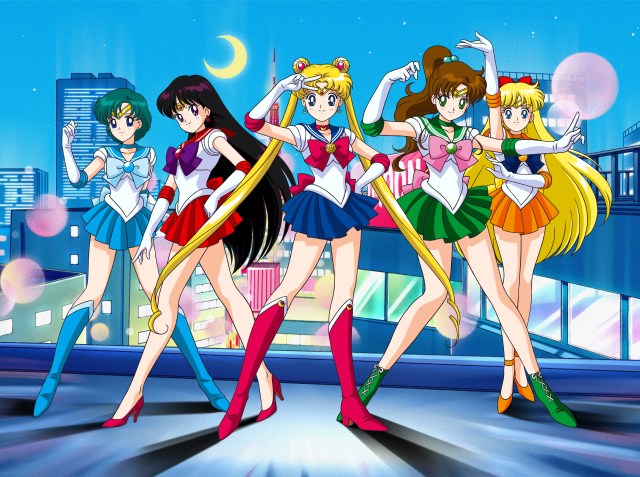
The summer of 2014 is shaping up to be a big one for Sailor Moon fans. For starters, there’s a new reboot TV series based on the comics airing in July, as I’ve covered before here. But a little over a week ago, Viz Media dropped what is possibly an even bigger bombshell. What could be bigger than a reboot of a ’90s TV classic, you say?
Viz announced it had picked up the entire ’90s classic itself, after the original anime had spent years out of print in the United States. It began releasing episodes of the series in Japanese with English subtitles online last Monday; they can be found on Hulu and on Viz’s own NeonAlley, with new ones added each week.
The rescue is really more than a rescue, but a rebirth, as the anime was officially released in-full in the United States. For the first time, all 200, unedited episodes of the series will be available to American fans. But perhaps even more excitingly, Viz announced that it would create a new, faithful English dub of the series, to be released on DVD and Blu-Ray later this year in half-season sets. The new dub’s cast will be revealed July 5 at LA’s Anime Expo, the same day of the reboot series’ worldwide premiere.
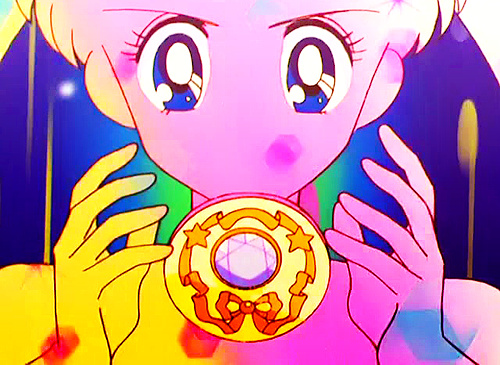
“Faithful,” of course, not only means that fans will get all of the episodes that were cut from the original dub release, and characterizations that hew closer to the original Japanese ones for Sailor Moon and her friends. It means that queer fans will finally get the real representation we deserved in Sailor Moon. The series was hugely influential around the world not only for its butt-kicking magical girls, but for helping queer girls come into their own with two lesbian Sailors, Uranus and Neptune (or Haruka and Michiru, using their “civilian” names). Yet, in the English dub – as well as many others – the queerness was deemed “inappropriate” for children and cut out. Uranus and Neptune were made to be platonic cousins and given tacked-on male love interests. In addition, a gay male couple in the first season was made into a heterosexual one, and the fifth season, which featured gender-bending Sailor Senshi, was never released in America at all.
All that is about to change, as the new dub – as well as the subtitled releases coming out bit-by-bit on Hulu – plan to keep things queer. As the new release’s producer, Josh Lopez, said in an interview with Anime News Network about the series: “What we’re trying to do is make something that pays honor and respect to the original version of this, and that means we’re offering everything to fans this time. It’s not going to be censored, we’re not going to hold back any episodes or seasons, you’re getting everything.”
What’s more, the new staff is personally invested in making sure that the queer content is depicted accurately for fans. When asked about the parts they were most excited about adapting, Charlene Ingram, Viz’s Senior Manager of Animation Marketing, said:
Everything from the third season onward, I’m most excited about. I’m really excited about Haruka and Michiru’s relationship, and keeping it true to the original. I think we’re living in a really exciting time where that won’t be seen as scandalous. I think it’ll just be seen as a beautiful romance. I’m happy that it’s not just “Oh no, there’s lesbian characters, scandal!” It’s like “No, these are two people that love each other and they make sacrifices for each other, isn’t that beautiful no matter what gender they are?”
One of the best things about the original Sailor Moon series — speaking as someone who has read the comics as well — is how consistently the relationships are portrayed across the series. Haruka and Michiru’s lesbian romance is portrayed as just as supportive and loving as Usagi and Mamoru’s heterosexual one, and both are put on equal footing with the platonic female friendships among the cast. Sailor Moon celebrates all kinds of relationships, and as a queer fan who discovered her own sexuality partly due to Sailor Moon, it feels good to have the US translators finally on our side.
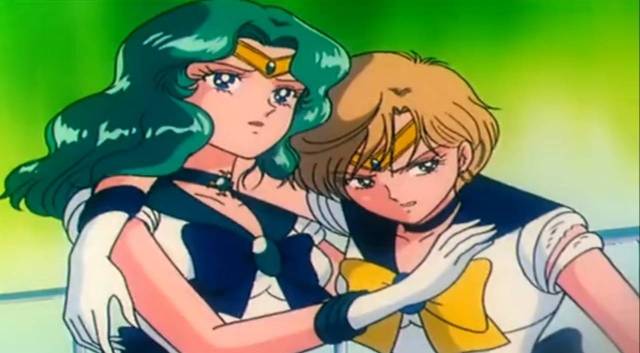
Everyone’s favorite superpowered anime lesbians
So, all that said, you’re probably wondering what I think of the episodes on Hulu so far. I watched the old DiC dub on TV as a kid, and even though I’m very familiar with much of the rest of the franchise (even the live-action series), this is my first go-around with the subtitled version of the anime. Here are some first impressions:
As much as I’ve spent the rest of the article trashing the old ’90s dub, these early Japanese episodes definitely make me appreciate a little of what it was trying to do. The early episodes contain a lot — and I mean, a lot — of repetitive filler. To give some idea, Sailor Mercury, the first addition to the team, comes along in episode 8 of the Japanese version, but episode 5 of the old English dub. While kids often have short attention spans and can handle more filler, they also get impatient if they see a cool character in the theme song and she’s taking a while to show up. I know I would have been frustrated as a kid to wait that long for Mercury (who also was my favorite character). Cutting some of that fat doesn’t lose a lot except for hardcore fans who want to see it all, and while I’m glad the power to pick and choose is now in our hands (considering all the other stuff that the DiC dub cut), I’m not sure how much this particular case adds.
It also changes a lot of the dialogue, which in some of these early episodes may have been for the better after all, as in one episode that centers around a fitness center. The Japanese version is full of intense fat-shaming of Usagi for her heavy eating (even though she still looks thin throughout the episode), not only from her friends and family but from Luna, her cat mentor. The DiC dub was much milder.
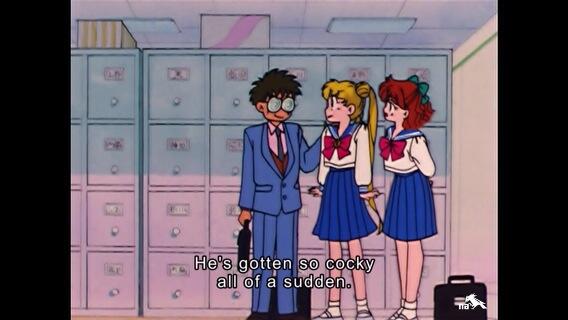
Umino, Usagi and Naru
The old dub also changed some characters’ personalities. The Japanese version of protagonist Usagi is perkier and more charming than the snarkier “Serena” (as she was called in the dub), and I’m not sure which version I prefer. But I do think I like the dubbed version of her friend Umino better; as “Melvin”, he was portrayed as a clueless nerd, annoying his friends because he didn’t know any better. In the Japanese, though, Umino is often just mean. It will be interesting to compare more characters as the series progresses. Lastly, while the DiC dub’s musical soundtrack fit each moment’s emotion exactly — scary music when our heroine is backed into a corner by villains, for instance — the Japanese version’s soundtrack is consistently jazzy and campy, never taking itself too seriously. Some may find this jarring or cheesy, especially if they don’t watch a lot of anime; I personally find it charming.
If all that sounds intimidating to a newbie, don’t worry! There are still a lot of things to recommend in these early episodes. While Usagi seemed useless and stupid to me when I was a little tyke who liked looking up to teenagers I watched on TV, she is far more endearing to my adult eyes. Her difficulty adjusting to life, fighting evil while also juggling bad grades and crushes makes her a relatable and strong character — especially knowing we’ll get to see her grow into a tough and capable woman later. There’s also some interesting patriarchal subtext in how a male villain, Jadeite, keeps choosing stereotypically-feminine hobbies and products — jewelry, weight-loss schemes, a love-letter hotline — to enact his energy-draining plots. When Usagi transforms into Sailor Moon to defeat him each time, she does so with a speech about the evils of preying on “young girls’ dreams”. It’s probably reading way too much into this series to interpret this as feminist commentary on consumer culture, but it still made me smile.
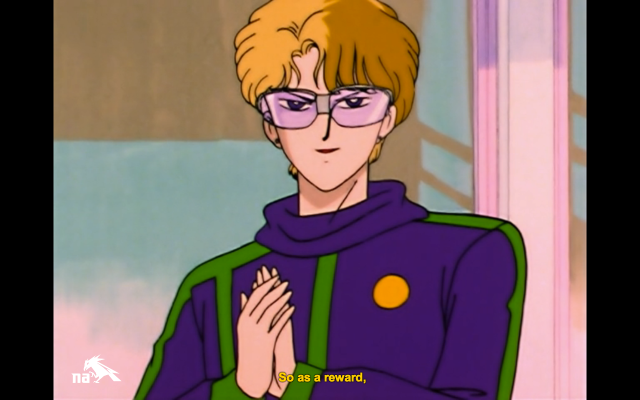
Jadeite in his super-’90s fitness attire
For the stumped-for-time, the website Den of Geek has an excellent Season 1 viewing guide for beginners, letting you know which episodes are must-sees and which can be skipped. Of the ones released so far on Hulu, only the series premiere is on their list. It’s worth checking out a couple more before Sailor Mercury shows up next week; I personally recommend episode 3, the “love letter” one, which was also included in the original English dub.
If you’re a long-time Sailor Moon fan like me, this summer is shaping up to be one full of wonderful surprises. If you’re not, but would like to check out this groundbreaking, and extremely feminist and queer, series, there has never been a better time!